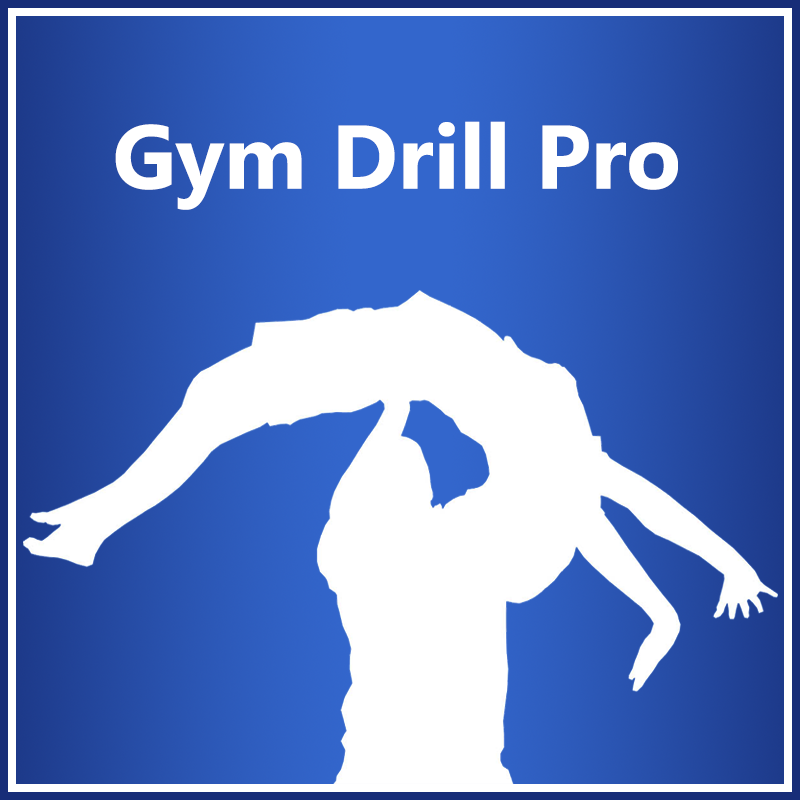

An integral part of the gymnastics coaching process is to provide athletes with drills to aid in their skill development. Drills can help gymnasts learn skills faster, and with the correct techniques. Gym Drill Pro aims to provide qualified coaches with a variety of teaching methods which they can introduce in their own training programs. On Gym Drill Pro you can find hundreds of detailed descriptions and accompanying images for every skill progression. This website is explicitly intended to support qualified coaches in their daily coaching processes. DO NOT practice any of these drills without the guidance of proper professionals.
The thigh muscles are heavily involved in gymnastics. The quadriceps might be the most important muscles in bouncing the spring on vault, tumbling, and they're critical for running, landing, and decelerating as well. The hamstrings might be the most important muscles in sprint running on the runaway vault line. In weight training, the quadriceps contribute considerably to the squat exercise and the hamstrings contribute considerably to the deadlift exercise. Because the hamstrings cross both the knee and hip joints, they play critical roles in transferring power from the knee joint to the hip joint during explosive movements, such as acrobatic passes on floor exercises and beam.
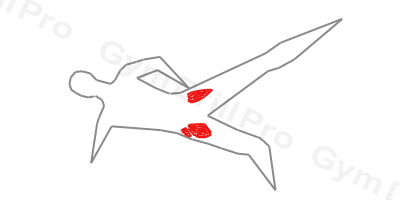
The glutes play a major role in most gymnastics moves. As an athlete matures from beginner to advanced to elite status, they learn to derive increasing amounts of propulsive power from the hips. Propulsive power is considerably influenced by the strength of the glutes because this muscle is heavily involved in nearly all primary gymnastics motions including running, pushing, jumping, kicking back, piking and arching, keeping the shape, rotating, and landing.
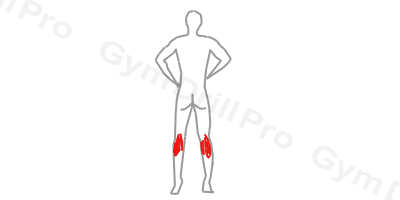
The calf muscles are highly activated when running, jumping, sprinting, and cutting from side to side. The soleus has been shown to be more important for vertical jumping than the gastrocnemius. The gastrocnemius has been shown to be highly activated during the propulsive phase of ground contact in sprinting. Therefore, you should strengthen both muscles. For sport purposes, it is important to not only possess strength in the lower leg musculature, but also power and stability. Plyometric activities, which repeatedly and rapidly contract and stretch the muscles, will help increase these qualities.

To possess an impressive back you need to strengthen all of the muscles that comprise the region. The trapezius muscle is an important shoulder mover and stabilizer. It contains upper, middle, and lower components. The upper trap fibers are involved in scapular (shoulder blade) elevation and scapular upward rotation and are even involved in neck extension, lateral neck flexion, and neck rotation. The middle trap fibers produce scapular adduction as well as slight scapular elevation and scapular upward rotation. The lower trap fibers are scapular depressors and scapular upward rotators. When the upper and lower trap fibers contract together, they assist the middle fibers in scapular adduction. The rhomboids work in concert with the traps to adduct the scapula, which explains why both muscles are collectively referred to as scapula retractors: They pull the shoulder blades together. The rhomboids are also downward rotators of the scapula. The spinal erectors have many responsibilities. Along with the multifidus, they extend the spine, help prevent the spine from flexing (rounding) during the swing and giants, and along with muscles such as the quadratus lumborum they laterally flex and rotate the spine.
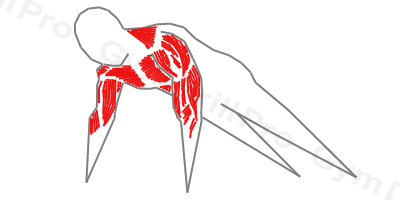
The arms are worked heavily during upper-body exercises that involve the movement of two or more joints at a time. All types of pull-up motions will sufficiently work the elbow flexors, and all types of push-up and dipping motions will sufficiently work the elbow extensors. For this reason, every time you train your chest, shoulders, and back you'll necessarily be working your arms.
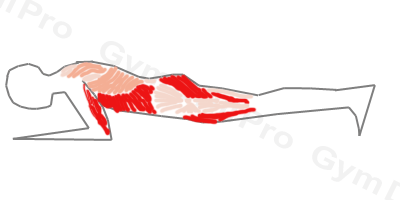
The core skills improve the ability to produce motion through concentric power, resist motion through isometric power, and absorb or decelerate motion through eccentric power. Each of these qualities is important in gymnastics. Not only does the chapter contain a balance of dynamic and static, or isometric, exercises, it also varies exercises in terms of planes and directions of movement. For example, planks skills are well suited for transferring to lateral movement, for transferring to forward and backward movement, for transferring to rotary movement. The chapter allows developing power, strength, and strength endurance in addition to well-developed abs. The athlete should execute correctly the exercise technique for the different areas of the core. The hips and thoracic spine (upper back) should be mobile and move efficiently; however, the spinal motion should be limited in the lumbar region. For example, when performing crunches and side crunches, the upper back should move the most while the lower back, or lumbar spine, moves the least. It is also essential to maintain good posture during core stability.
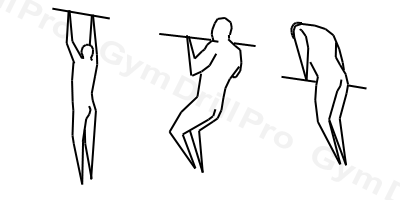
During whole-body exercises, the upper body, core, and lower body all work statically or dynamically throughout the set. For example, during the muscle up on rings, triceps, and biceps muscles contract dynamically to alternate between push-ups and the dips, while lower body muscles isometrically keep the body straight. Whole-body exercises are a valuable tool that can help take your body composition to the next level. As you gain physical fitness, your workouts will become increasingly more productive, allowing you to expend a greater amount of energy during training.
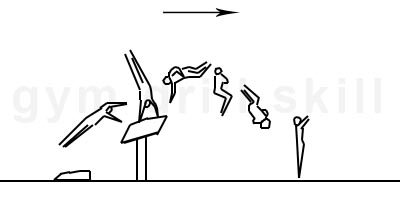
The Kasamatsu vault is similar to the Tsukahara full twist. In the Kasamatsu vault, the body starts turning away from the horse from the quarter turned position in the pre-flight. For example, if the gymnast has done a left quarter turn to get onto the horse, the last push should happen from the right hand. Then, the body should turn to the left (away from the horse). This is the same direction as the first quarter turn in the pre-flight. The blocking action from the right shoulder should finish with the body facing forward. The first half turn action should already be completed at this point. If the gymnast does a front somersault and a half turn from here, the body will have completed a full twist. The gymnast should land facing the horse.
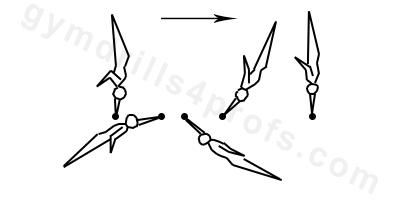
A back giant one arm is similar to a regular back giant. The skill usually starts from back giant at the handstand position. The gymnast transfers their center of gravity onto the holding arm. At the last quarter of the giant, the gymnast shifts their wrist. When a full rotation is completed, the gymnast places the free hand on the bar. It’s critically important that the gymnast has a strong grip. In order to achieve this goal, the athlete should exercise by squeezing tennis balls or various hand strengtheners.
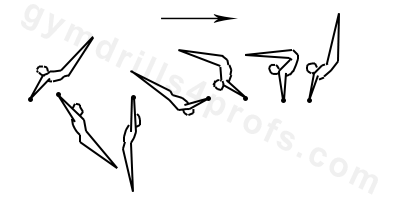
The Giant swing rearways forward ( Russian, Italian) can be done from an adler, or from some turn, for example, Higgins. The giant is performed in L-grip. From handstand the body is completely straight, the head is insight. From a hang, the gymnast kicks back with the feet, and the body is slightly arched. Around horizontal, the body starts piking until it reaches the higher vertical. At this point the legs raise and the skill finishes in a handstand. The gymnast should emphasize on the flat bail in the first part and on the proper technique of piking. They should also emphasize on extending to handstand in the second part of the skill. In order to do this skill, the gymnast should have flexible shoulders which can hold support in L-grip. The hands during the execution should as close as possible.
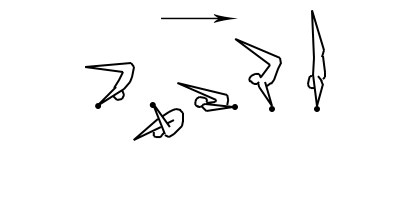
For an Adler/Jam/Stoop there are two main techniques for the first part of the skill. The first option is to start the dorsal circle from a handstand. The gymnasts finish their giant swing forwards and after they reached the upper vertical line (handstand with extended shoulders), they stoop in. For the second technique, the gymnasts do not finish their giant swing. Shortly after they pass the horizontal line on the high bar they bend their hip angle for the stoop in. The gymnasts pike their body to their maximum, placing their feet between their hands. For the first 90 degrees, the gymnasts should keep their shoulder angle open. From the lower vertical they should begin to raise their hips and open the shoulder angle. At the handstand, the athletes should shift their shoulders into an L-grip, and raise their legs until their body is completely extended.
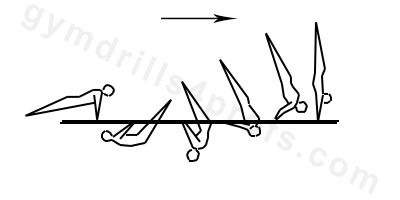
Peach/basket to handstand is a very high level technical skill. The gymnasts who are doing this skill should already have a significant amount of experience, strength, flexibility, and coordination. The gymnast should be knowledgeable and have a clear understanding of swings on the parallel bars. It is especially important that the gymnast is experienced with a piked swing under the bars. The skill can be done from handstand or front support. The gymnast should perform a backward roll to candlestick or reversed pike. At this stage in the skill, it’s important that the hips are away from the gymnast’s hands. Simply said, it has to be a free hip, not a back hip circle. Keeping the hips far away helps the gymnast to obtain a wide circle, which will give them enough speed for the second part of the skill. If the hips are too close to the hands, the circle is cut short and as a consequence the skill will move slower. When the gymnast’s shoulders are at the lower part between the bars, the second part of the skill begins. The gymnast should gradually open the angle of the shoulders, push back on the rails, and open the body from pike to hollow. Pushing on the bars helps to stop the back flipping and transform it into a upwards momentum. This will raise the gymnast’s body to vertical. Opening the body from pike to vertical will help the gymnast accelerate the speed and send the direction up to handstand. The grip is inward and the gymnast should hold the rails for as long as possible. It helps to feel the support position and push on the bars. At the last moment of the skill, the gymnast should switch their hands and finish in a handstand position.